Key takeaways:
- Digital abuse includes harassment, stalking, and manipulation through technology, profoundly impacting victims’ mental health and self-worth.
- This issue disproportionately affects marginalized groups, particularly women, reinforcing harmful gender stereotypes and silencing voices advocating for equality.
- Recognizing signs of digital abuse is crucial for individual well-being, including belittling comments, anxiety about online interactions, and controlling behaviors.
- Open communication, education on digital etiquette, and strict reporting mechanisms on platforms are vital strategies to combat digital abuse and foster safer online environments.
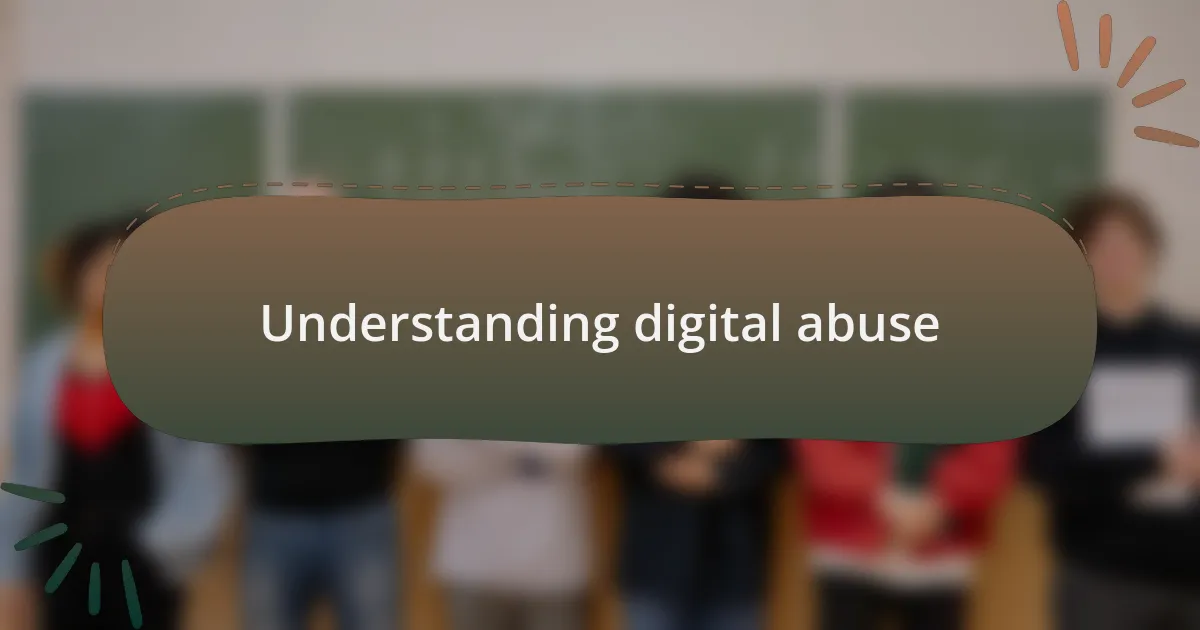
Understanding digital abuse
Digital abuse is often subtle but can be incredibly damaging. It encompasses a range of behaviors including harassment, stalking, and manipulation that occur through technology. I recall a friend who faced relentless online bullying, and it made me realize how these actions can erode someone’s sense of safety and self-worth.
As I delve deeper into this topic, I can’t help but wonder: how often do we overlook the emotional implications of digital interactions? Digital abuse can feel isolating, leaving victims to suffer in silence. It’s not just the harsh words or invasive actions that hurt; it’s the lingering fear and anxiety they instill that can impact every aspect of a person’s life.
Reflecting on my experiences with communication through social media, I’ve seen how easily lines can be crossed. An innocuous message can quickly become an insidious tool for control or intimidation. It’s vital to understand that digital abuse isn’t just a personal issue; it has societal implications that we all need to address collectively.
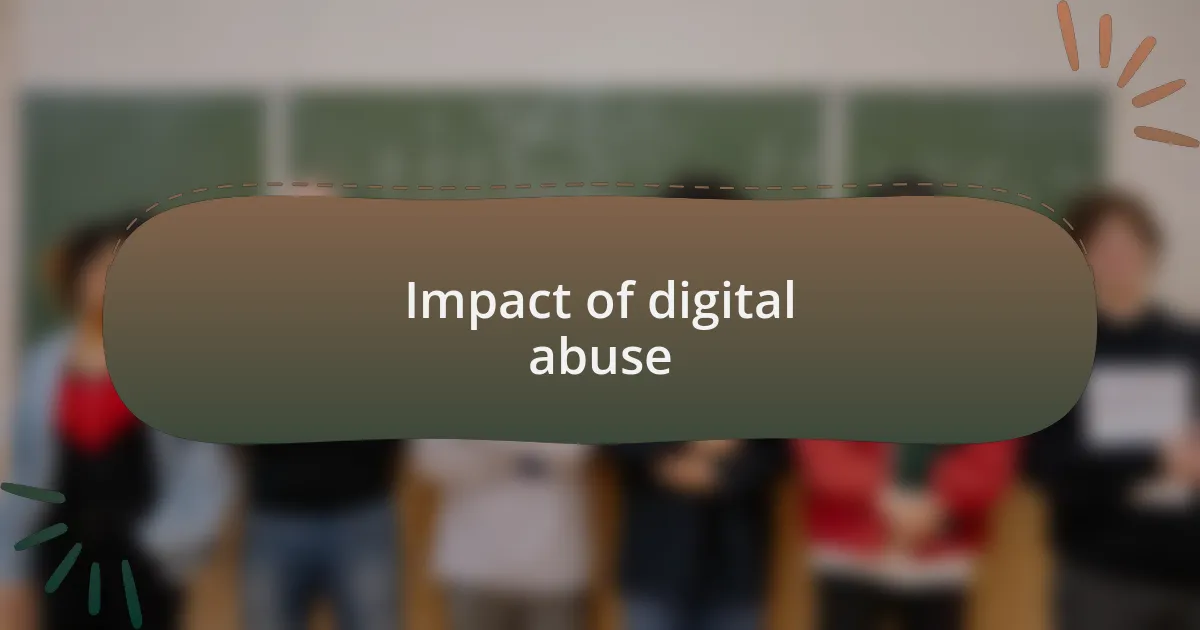
Impact of digital abuse
The impact of digital abuse stretches far beyond immediate harm; it can create lasting psychological scars. I remember an incident where a colleague faced an onslaught of derogatory messages online, stoking her anxiety and leading her to withdraw from social interactions. How many potential friendships or opportunities are lost because someone feels unsafe in a digital space?
In my observations, victims often experience a profound sense of helplessness. Digital abuse can warp one’s self-image, making them question their value and worth. I’ve seen friends become shadow versions of themselves, whispering their thoughts rather than sharing them, a painful transformation triggered by relentless trolling. It raises an important question: how much longer can we tolerate a culture that allows such behavior to flourish?
Moreover, the societal implications of digital abuse are alarming. As I engage with various communities online, I often ponder how these aggressive behaviors can normalize disrespect and dehumanization. With every unchecked act of digital abuse, we risk cultivating a future where compassion and empathy are overshadowed by hostility. It’s a challenge we must confront together, ensuring that our digital interactions mirror the respect we crave in real life.
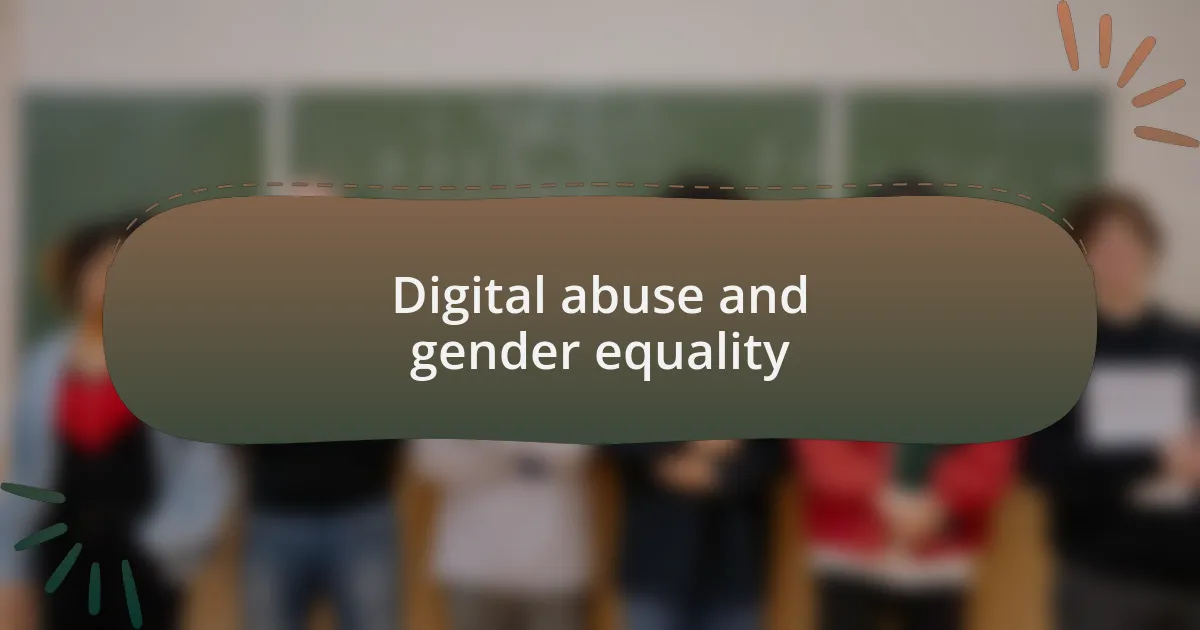
Digital abuse and gender equality
Digital abuse significantly undermines gender equality by reinforcing harmful stereotypes and power dynamics. I recall a conversation with a young woman who faced relentless online harassment simply for sharing her opinions on gender issues. Listening to her story, I couldn’t help but ask: how can we promote gender equality when digital platforms become breeding grounds for misogyny and intimidation?
The insidious nature of digital abuse often silences marginalized voices, particularly women, who are disproportionately targeted. In my experience, I’ve witnessed countless individuals curtail their online presence due to fears of retaliation. It’s heartbreaking to think that a platform meant for expression can morph into a space of fear that stifles crucial conversations about equality.
As I reflect on these incidents, I realize that the fight against digital abuse must align closely with gender equality efforts. We need to actively create safe virtual environments where everyone has the freedom to express themselves without fear. Isn’t it time we redefined our online spaces to reflect the values of inclusivity and respect we cherish in our physical communities?
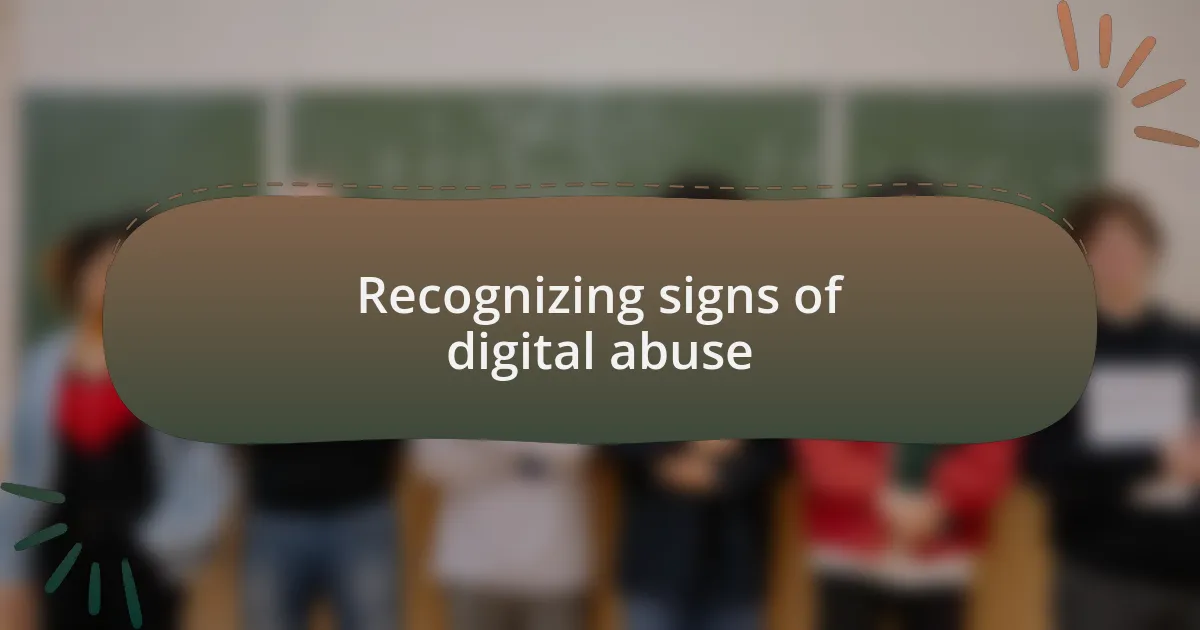
Recognizing signs of digital abuse
Recognizing the signs of digital abuse is crucial for fostering a safe online environment. For instance, if someone frequently receives belittling comments or threatening messages, it may indicate a pattern of digital harassment. I remember a friend who would often come to me feeling demoralized after checking her social media, as trolling comments had begun to affect her self-esteem significantly. This made me wonder: how many others are enduring similar experiences in silence?
Another telling sign of digital abuse is when a person feels anxious about their online interactions or begins avoiding digital platforms altogether. I once spoke with a colleague who decided to deactivate her accounts after experiencing constant negativity online. Witnessing her struggle highlighted the emotional toll digital abuse can take, prompting me to ask: why should anyone need to retreat from spaces meant for connection and collaboration?
Finally, digital abuse can manifest through controlling behaviors, such as someone monitoring or dictating what you can share online. It’s alarming how often this is overlooked. A former classmate once confided in me about her partner who demanded she remove certain posts, claiming they brought “too much attention.” This kind of manipulation raises many questions about consent and respect in relationships, and it’s vital that we help individuals recognize such red flags for their well-being.
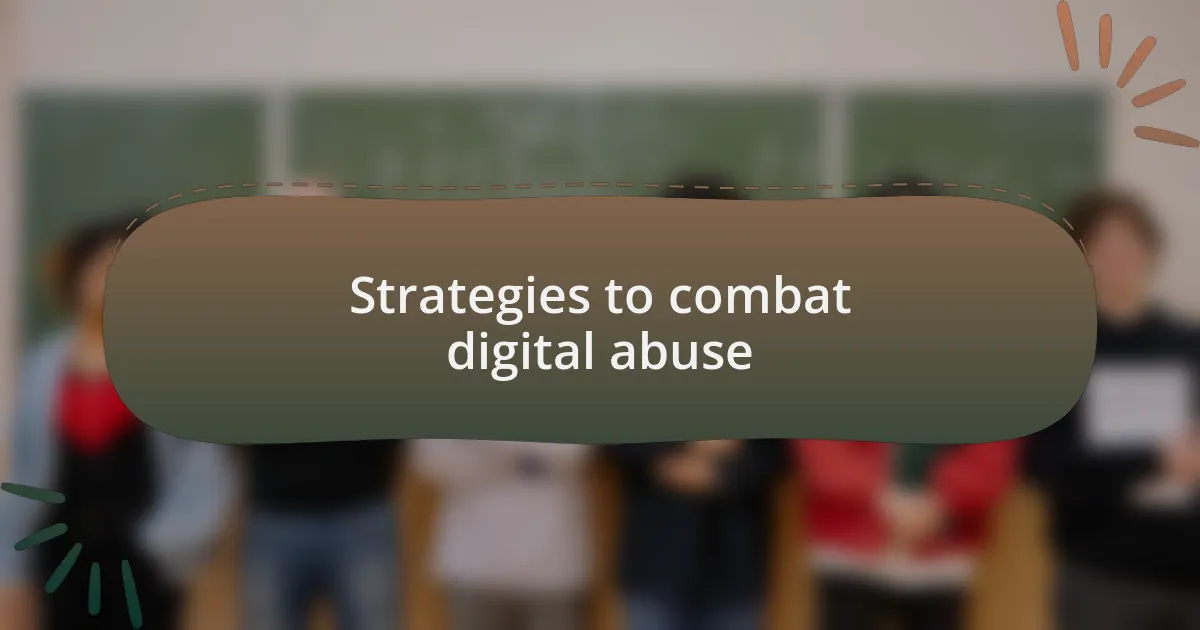
Strategies to combat digital abuse
One effective strategy to combat digital abuse is to foster open communication and support within friendships and communities. I remember a time when a friend confided in me about experiencing harassment online, and instead of brushing it off, we created a small group where we could share our experiences and strategies for dealing with such negativity. This collective approach not only empowered us, but it also reinforced the idea that no one should suffer in silence. Have you ever thought about how a supportive network could change someone’s experience online?
Education plays a pivotal role in addressing digital abuse. I once participated in a workshop that focused on digital citizenship, where we discussed the importance of respectful online interactions. It struck me how many people lacked awareness about the consequences of their digital behavior. Isn’t it fascinating how a little knowledge can go a long way in preventing harmful actions? By raising awareness about digital etiquette and the impact it has on others, we can help create a more respectful online environment.
Lastly, implementing strict reporting mechanisms on social media platforms can significantly deter abusive behavior. I recall a time when a social media campaign encouraged users to report incidents of abuse, leading to a noticeable decrease in trolling within that community. It made me realize that when platforms take user safety seriously, they can help foster an atmosphere where individuals feel more secure. Isn’t it essential for these platforms to prioritize the wellbeing of their users over mere engagement metrics?
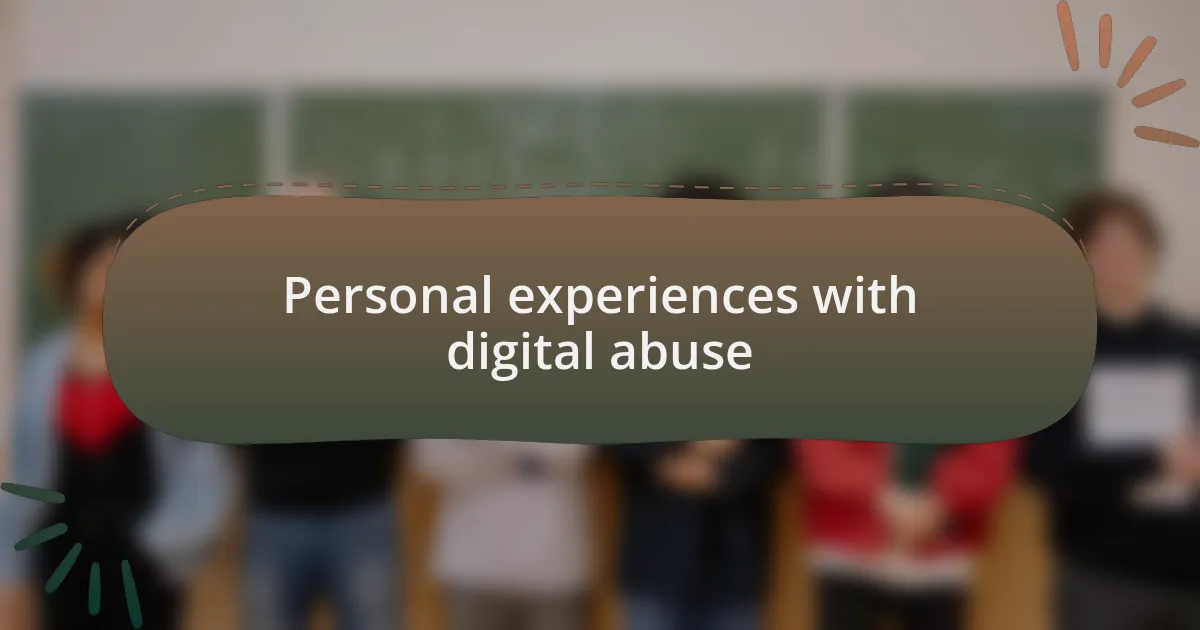
Personal experiences with digital abuse
The first time I encountered digital abuse was in an online forum where I shared my thoughts about a sensitive topic. I was met with a barrage of negative comments that made me doubt myself. It was shocking to see how anonymity can embolden hurtful behavior. Have you ever felt like the harsh words of strangers can echo louder than the support of friends?
Another instance that stands out for me was when a close friend experienced severe cyberbullying. I witnessed the toll it took on her mental health, leading her to withdraw from our social circles. It was heartbreaking to see someone so vibrant and full of life become a shadow of herself due to the cruelty of others online. This experience made me realize the lasting impact of digital abuse. How can we help someone find their voice again when they feel silenced by fear?
Reflecting on these experiences, I often ponder whether platforms truly understand the weight of their responsibility in curbing digital abuse. I remember attending a discussion on the lack of accountability for online behavior, which left me both frustrated and motivated. It sparked a fire in me to advocate for changes that prioritize user safety. Don’t you think it’s time to hold these platforms accountable for the environments they create?
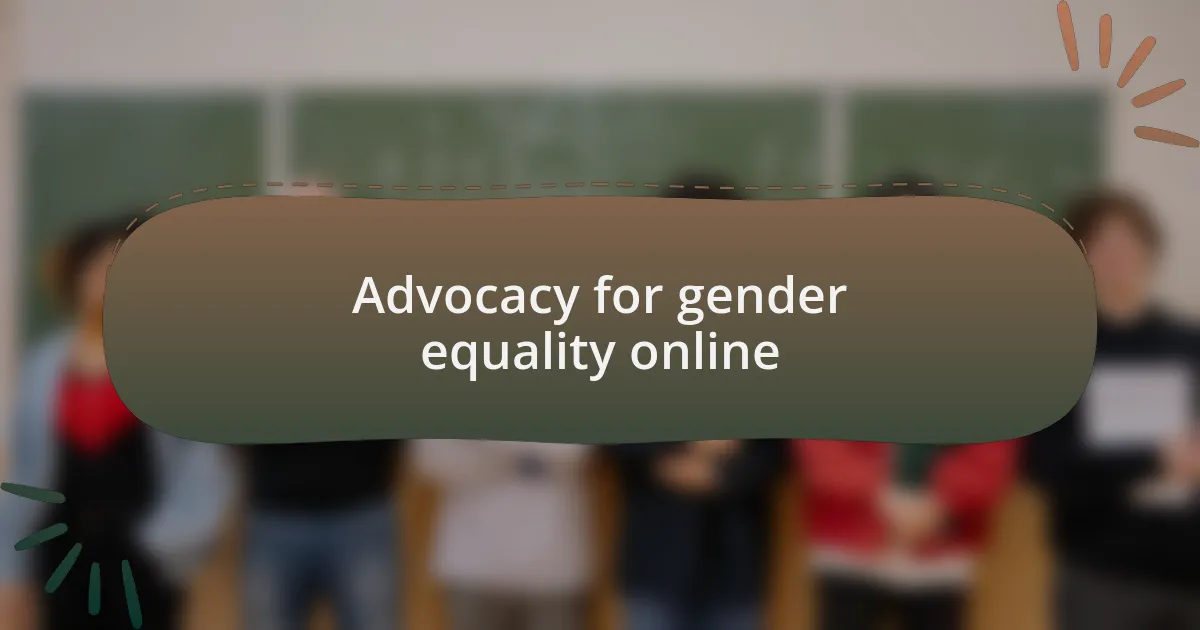
Advocacy for gender equality online
Advocacy for gender equality online is crucial, especially when we consider how digital spaces can amplify voices, but also amplify harm. I recall a time when I joined an online campaign pushing for safer social media environments. It was empowering to connect with others who shared my passion, yet it was disheartening to witness some dismiss our concerns as mere “internet drama.” Why is it so hard for some to see that online platforms should be spaces of respect and support rather than breeding grounds for hostility?
Engaging in conversations about gender equality online requires both courage and commitment from everyone involved. I participated in a webinar a few months ago, where we discussed strategies for creating safer online environments for marginalized voices. I was struck by a speaker who shared how they had developed community guidelines that respected everyone, which drastically improved the tone of discussions. Are we not responsible for maintaining safe digital spaces just as much as we are in our physical communities?
Taking action towards gender equality online can start with individual choices. In my effort to combat toxic discussions, I have made it a point to call out inappropriate comments and support those who feel silenced. I often ask myself, “What can I do today to make the online landscape more inclusive?” Small acts of advocacy, like uplifting others’ voices or reporting abusive content, can pave the way to a digital environment that values equality and fosters understanding. Isn’t it time we all committed to that?